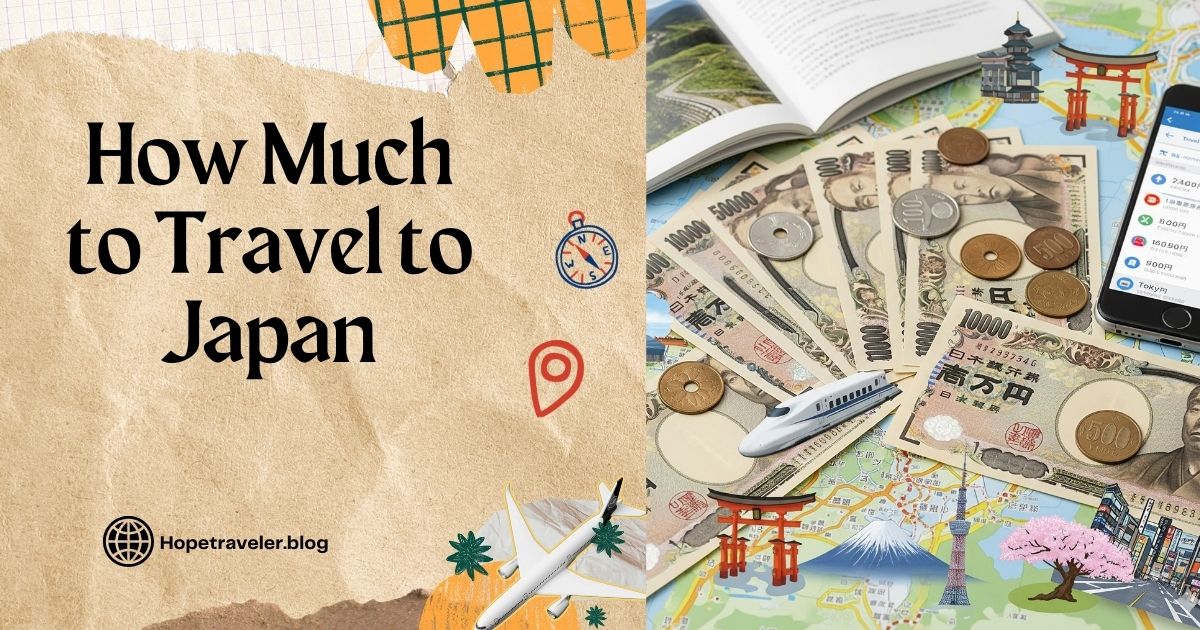Introduction
Japan is one of the most fascinating travel destinations in the world, known for its unique blend of tradition and modernity. Tourists are attracted to its historic temples, high-tech cities, cherry blossoms, culinary delights, and cultural experiences. But before planning a trip, many travelers ask an important question: How much to travel to Japan?
The cost of traveling to Japan depends on several factors such as airfare, accommodation, food, transport, and sightseeing. In this article, we’ll break down each expense category, provide practical estimates, and explain how to budget for a fulfilling trip. For an overview of the country, you can explore Japan on Wikipedia.
Airfare to Japan
One of the largest expenses when traveling to Japan is the airfare. Prices vary depending on the traveler’s location, season, and airline choice.
- From North America: Round-trip flights can range from $600 to $1,200 depending on the city and season.
- From Europe: Expect costs between $700 and $1,400 for economy class tickets.
- From Southeast Asia: Cheaper flights are available, often ranging from $200 to $500.
- From Australia: Round-trip tickets usually cost between $500 and $900.
Seasonal Variations
- Peak season (spring cherry blossoms in March–April and autumn foliage in October–November) sees higher prices.
- Off-season (summer and winter, excluding holidays) usually offers more affordable airfare.
Accommodation Costs
Japan offers a wide variety of lodging options, from traditional inns to luxury hotels.
- Hostels and Capsule Hotels: $20–$40 per night, popular among budget travelers.
- Business Hotels: $50–$80 per night, offering compact rooms with basic amenities.
- Ryokan (Traditional Japanese Inns): $100–$250 per night, often including dinner and breakfast.
- Luxury Hotels: $200–$500+ per night, depending on the city and brand.
Staying in a ryokan or temple lodging can add cultural value to your trip, though at a higher price.
Food and Dining in Japan
Japanese cuisine is one of the highlights of visiting the country, and costs vary widely depending on where you eat.
- Convenience Stores: Quick meals (sandwiches, rice balls, noodles) for $3–$5.
- Casual Restaurants: Ramen, curry rice, or donburi for $6–$12.
- Mid-range Dining: Sushi, izakaya meals, or teishoku sets for $15–$30.
- Fine Dining: High-end sushi or kaiseki experiences can cost $100–$300 per person.
On average, budget travelers can spend around $20–$30 per day on food, while those seeking variety and premium experiences may spend $60–$100 per day.
Transportation Costs
Japan’s transportation system is one of the best in the world, but it can also be costly.
Japan Rail Pass
For international tourists, the Japan Rail Pass offers unlimited travel on JR trains for a set period.
- 7-day pass: around $250
- 14-day pass: around $400
- 21-day pass: around $520
This is ideal for those traveling between major cities such as Tokyo, Kyoto, Osaka, and Hiroshima.
Local Transport
- Subway/Bus Rides: $2–$4 per trip.
- Day Passes: $6–$10 for unlimited city travel.
- Taxis: Starting fare around $5–$7, with additional charges per kilometer.
Budget travelers can expect to spend $10–$20 daily on city transport, while those taking long-distance trains will need to plan for more.
Sightseeing and Activities
Entry fees for attractions in Japan are relatively affordable compared to Western countries.
- Temples and Shrines: $3–$6 per entry.
- Museums: $5–$15.
- Theme Parks: Tokyo Disneyland or Universal Studios Japan cost around $60–$80 for a day ticket.
- Cultural Experiences: Tea ceremonies, kimono rentals, or sumo events range from $20–$100.
Travelers should budget around $15–$30 per day for sightseeing, though theme parks and special activities can increase expenses.
Shopping and Souvenirs
Japan is famous for shopping, from high-end electronics to traditional crafts. The amount spent depends on individual preferences.
- Small Souvenirs: $5–$20 (keychains, chopsticks, snacks).
- Fashion and Cosmetics: $50–$200 depending on brands.
- Electronics: Prices vary but can be comparable to international rates.
On average, budget $100–$300 for souvenirs and shopping during a trip.
Daily Budget Estimates
Here’s a breakdown of daily travel costs for different budgets:
- Budget Traveler: $50–$80 (hostel, cheap meals, public transport, basic sightseeing).
- Mid-range Traveler: $120–$200 (business hotels, varied meals, some long-distance travel).
- Luxury Traveler: $300–$600+ (luxury hotels, fine dining, private tours, shopping).
Example Trip Costs
For a 10-day trip to Japan, estimated costs are:
- Budget: $1,200–$1,600
- Mid-range: $2,000–$3,000
- Luxury: $4,000–$6,000+
This includes airfare, accommodation, food, transportation, and sightseeing.
Tips to Save Money While Traveling to Japan
- Book Flights Early – Plan 3–6 months in advance for lower airfare.
- Use the JR Pass – If visiting multiple cities, this can save hundreds of dollars.
- Eat at Convenience Stores and Local Spots – Affordable yet tasty meals are widely available.
- Stay in Capsule Hotels – Unique and cheaper than traditional hotels.
- Travel Off-Season – Avoid cherry blossom and autumn foliage crowds.
Conclusion
So, how much to travel to Japan? The answer depends on travel style and preferences. Budget travelers can enjoy the country with around $1,500 for 10 days, while mid-range and luxury travelers may spend significantly more.
What’s certain is that Japan offers value for every type of traveler — whether you want to explore ancient temples, enjoy modern cities, or indulge in world-class cuisine. By understanding the costs of airfare, accommodation, food, transport, and activities, you can plan your dream trip efficiently.
For more information about the country, its culture, and history, check out Japan on Wikipedia.




